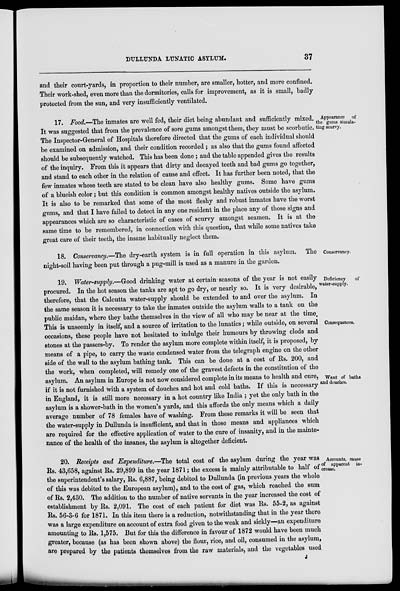Medicine - Mental health > 1867-1924 - Annual report of the insane asylums in Bengal > Insane asylums in Bengal annual reports 1867-1875 > Annual report on the insane asylums in Bengal for the year 1872
(549) Page 37
Download files
Individual page:
Thumbnail gallery: Grid view | List view

DULLUNDA LUNATIC ASYLUM. 37
and their court-yards, in proportion to their number, are smaller, hotter, and more confined.
Their work-shed, even more than the dormitories, calls for improvement, as it is small, badly
protected from the sun, and very insufficiently ventilated.
Appearance of
the gums simula-
ting scurvy.
17. Food.—The inmates are well fed, their diet being abundant and sufficiently mixed.
It was suggested that from the prevalence of sore gums amongst them, they must be scorbutic.
The Inspector-General of Hospitals therefore directed that the gums of each individual should
be examined on admission, and their condition recorded ; as also that the gums found affected
should be subsequently watched. This has been done ; and the table appended gives the results
of the inquiry. From this it appears that dirty and decayed teeth and bad gums go together,
and stand to each other in the relation of cause and effect. It has further been noted, that the
few inmates whose teeth are stated to be clean have also healthy gums. Some have gums
of a blueish color; but this condition is common amongst healthy natives outside the asylum.
It is also to be remarked that some of the most fleshy and robust inmates have the worst
gums, and that I have failed to detect in any one resident in the place any of those signs and
appearances which are so characteristic of cases of scurvy amongst seamen. It is at the
same time to be remembered, in connection with this question, that while some natives take
great care of their teeth, the insane habitually neglect them.
Conservancy.
18. Conservancy.—The dry-earth system is in full operation in this asylum. The
night-soil having been put through a pug-mill is used as a manure in the garden.
Deficiency of
water-supply.
Consequences.
Want of baths
and douches.
19. Water-supply.—Good drinking water at certain seasons of the year is not easily
procured. In the hot season the tanks are apt to go dry, or nearly so. It is very desirable,
therefore, that the Calcutta water-supply should be extended to and over the asylum. In
the same season it is necessary to take the inmates outside the asylum walls to a tank on the
public maidan, where they bathe themselves in the view of all who may be near at the time.
This is unseemly in itself, and a source of irritation to the lunatics; while outside, on several
occasions, these people have not hesitated to indulge their humours by throwing clods and
stones at the passers-by. To render the asylum more complete within itself, it is proposed, by
means of a pipe, to carry the waste condensed water from the telegraph engine on the other
side of the wall to the asylum bathing tank. This can be done at a cost of Rs. 200, and
the work, when completed, will remedy one of the gravest defects in the constitution of the
asylum. An asylum in Europe is not now considered complete in its means to health and cure,
if it is not furnished with a system of douches and hot and cold baths. If this is necessary
in England, it is still more necessary in a hot country like India ; yet the only bath in the
asylum is a shower-bath in the women's yards, and this affords the only means which a daily
average number of 78 females have of washing. From these remarks it will be seen that
the water-supply in Dullunda is insufficient, and that in those means and appliances which
are required for the effective application of water to the cure of insanity, and in the mainte-
nance of the health of the insanes, the asylum is altogether deficient.
Accounts, cause
of apparent in-
crease.
20. Receipts and Expenditure.—The total cost of the asylum during the year was
Rs. 43,658, against Rs. 29,899 in the year 1871; the excess is mainly attributable to half of
the superintendent's salary, Rs. 6,887, being debited to Dullunda (in previous years the whole
of this was debited to the European asylum), and to the cost of gas, which reached the sum
of Rs. 2,430. The addition to the number of native servants in the year increased the cost of
establishment by Rs. 2,091. The cost of each patient for diet was Rs. 55-2, as against
Rs. 56-3-6 for 1871. In this item there is a reduction, notwithstanding that in the year there
was a large expenditure on account of extra food given to the weak and sickly—an expenditure
amounting to Rs. 1,575. But for this the difference in favour of 1872 would have been much
greater, because (as has been shown above) the flour, rice, and oil, consumed in the asylum,
are prepared by the patients themselves from the raw materials, and the vegetables used
J
Set display mode to: Large image | Zoom image | Transcription
Images and transcriptions on this page, including medium image downloads, may be used under the Creative Commons Attribution 4.0 International Licence unless otherwise stated. ![]()
| Permanent URL | https://digital.nls.uk/83379647 |
|---|




